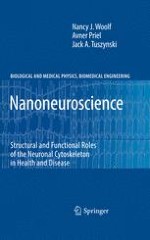2010 | OriginalPaper | Chapter
Nanotechnology, Nanostructure, and Nervous System Disorders
Authors : Nancy J. Woolf, Avner Priel, Jack A. Tuszynski
Published in: Nanoneuroscience
Publisher: Springer Berlin Heidelberg
Activate our intelligent search to find suitable subject content or patents.
Select sections of text to find matching patents with Artificial Intelligence. powered by
Select sections of text to find additional relevant content using AI-assisted search. powered by
Nanoscience impacts on nervous system diseases in at least two distinct ways. Nanomechanical structures within neurons are fundamentally impaired in multiple nervous system disorders and nanotechnology is instrumental to the development of novel drug and gene therapies and prosthetic nanodevices. A striking number of neurodevelopmental, neurological, and neuropsychiatric disorders exhibit disruption of the nanomechanical properties of the cytoskeleton, affecting subunit proteins, binding proteins, related signal transduction molecules, or indirectly impairing transport mechanisms. The neurodevelopmental disorders such as the fragile X syndrome, Turner syndrome, Williams syndrome, autism, Rett syndrome, and Down syndrome are associated with abnormalities to dendrites and spines, indicating underlying cytoskeletal involvement. Motor neuron diseases, such as amyotrophic lateral sclerosis, and degenerative neurological disorders, such as Alzheimer’s, Parkinson’s, and Huntington’s disease, present with profound disruption of the neuronal cytoskeleton, as well as compromised axonal transport. There is also evidence of cytoskeletal abnormalities in neuropsychiatric disorders, such as schizophrenia, bipolar disorder, and major depression. Identifying the genetic causes of nervous system disorders leads to new treatment targets. The genetic basis for many neurodevelopmental disorders is known, and in many cases expression of a cytoskeleton–related protein is abnormal. The genetic basis for many neurological and neuropsychiatric disorders remains largely undetermined; however, in those sporadic cases that have a gene locus specified, a deficit in a cytoskeleton–related proteins or impaired transport is often noted. Nanotechnological approaches to neurodevelopmental, neurological, and neuropsychiatric disorders include (1) using nanoparticles or nanocarriers to deliver drug or gene therapies, (2) using nanotechnology to reconstruct, reinforce, and/or stabilize the cytoskeletal matrix, (3) using nanofabrication methods to make biohybrid transport devices, and (4) coating electrodes with nanoparticles. Tangentially related to nanotechnological approaches are rational drug design techniques. High throughput scanning of huge molecular databases can be used to identify potential drugs that will target specific proteins in damaged neurons in an effort to restore nanomechanical function.
